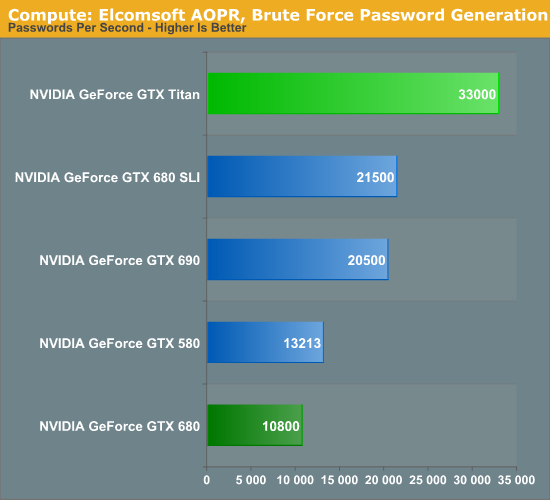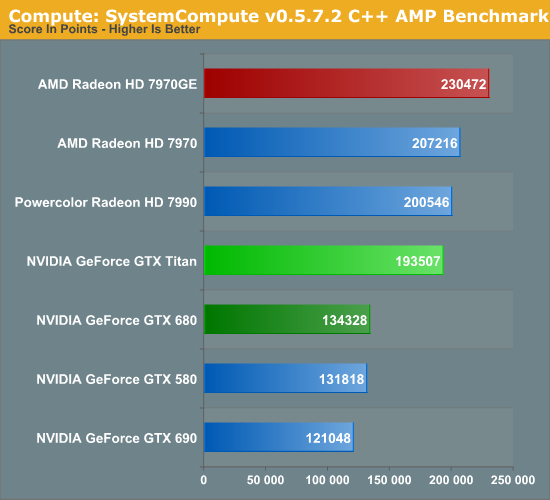NVIDIA’s GeForce GTX Titan Review, Part 2: Titan's Performance Unveiled
by Ryan Smith & Rahul Garg on February 21, 2013 9:00 AM ESTTitan’s Compute Performance, Cont
With Rahul having covered the basis of Titan’s strong compute performance, let’s shift gears a bit and take a look at real world usage.
On top of Rahul’s work with Titan, as part of our 2013 GPU benchmark suite we put together a larger number of compute benchmarks to try to cover real world usage, including the old standards of gaming usage (Civilization V) and ray tracing (LuxMark), along with several new tests. Unfortunately that got cut short when we discovered that OpenCL support is currently broken in the press drivers, which prevents us from using several of our tests. We still have our CUDA and DirectCompute benchmarks to look at, but a full look at Titan’s compute performance on our 2013 GPU benchmark suite will have to wait for another day.
For their part, NVIDIA of course already has OpenCL working on GK110 with Tesla. The issue is that somewhere between that and bringing up GK110 for Titan by integrating it into NVIDIA’s mainline GeForce drivers – specifically the new R314 branch – OpenCL support was broken. As a result we expect this will be fixed in short order, but it’s not something NVIDIA checked for ahead of the press launch of Titan, and it’s not something they could fix in time for today’s article.
Unfortunately this means that comparisons with Tahiti will be few and far between for now. Most significant cross-platform compute programs are OpenCL based rather than DirectCompute, so short of games and a couple other cases such as Ian’s C++ AMP benchmark, we don’t have too many cross-platform benchmarks to look at. With that out of the way, let’s dive into our condensed collection of compute benchmarks.
We’ll once more start with our DirectCompute game example, Civilization V, which uses DirectCompute to decompress textures on the fly. Civ V includes a sub-benchmark that exclusively tests the speed of their texture decompression algorithm by repeatedly decompressing the textures required for one of the game’s leader scenes. While DirectCompute is used in many games, this is one of the only games with a benchmark that can isolate the use of DirectCompute and its resulting performance.
Note that for 2013 we have changed the benchmark a bit, moving from using a single leader to using all of the leaders. As a result the reported numbers are higher, but they’re also not going to be comparable with this benchmark’s use from our 2012 datasets.

With Civilization V having launched in 2010, graphics cards have become significantly more powerful since then, far outpacing growth in the CPUs that feed them. As a result we’ve rather quickly drifted from being GPU bottlenecked to being CPU bottlenecked, as we see both in our Civ V game benchmarks and our DirectCompute benchmarks. For high-end GPUs the performance difference is rather minor; the gap between GTX 680 and Titan for example is 45fps, or just less than 10%. Still, it’s at least enough to get Titan past the 7970GE in this case.
Our second test is one of our new tests, utilizing Elcomsoft’s Advanced Office Password Recovery utility to take a look at GPU password generation. AOPR has separate CUDA and OpenCL kernels for NVIDIA and AMD cards respectively, which means it doesn’t follow the same code path on all GPUs but it is using an optimal path for each GPU it can handle. Unfortunately we’re having trouble getting it to recognize AMD 7900 series cards in this build, so we only have CUDA cards for the time being.

Password generation and other forms of brute force crypto is an area where the GTX 680 is particularly weak, thanks to the various compute aspects that have been stripped out in the name of efficiency. As a result it ends up below even the GTX 580 in these benchmarks, never mind AMD’s GCN cards. But with Titan/GK110 offering NVIDIA’s full compute performance, it rips through this task. In fact it more than doubles performance from both the GTX 680 and the GTX 580, indicating that the huge performance gains we’re seeing are coming from not just the additional function units, but from architectural optimizations and new instructions that improve overall efficiency and reduce the number of cycles needed to complete work on a password.
Altogether at 33K passwords/second Titan is not just faster than GTX 680, but it’s faster than GTX 690 and GTX 680 SLI, making this a test where one big GPU (and its full compute performance) is better than two smaller GPUs. It will be interesting to see where the 7970 GHz Edition and other Tahiti cards place in this test once we can get them up and running.
Our final test in our abbreviated compute benchmark suite is our very own Dr. Ian Cutress’s SystemCompute benchmark, which is a collection of several different fundamental compute algorithms. Rahul went into greater detail on this back in his look at Titan’s compute performance, but I wanted to go over it again quickly with the full lineup of cards we’ve tested.

Surprisingly, for all of its performance gains relative to GTX 680, Titan still falls notably behind the 7970GE here. Given Titan’s theoretical performance and the fundamental nature of this test we would have expected it to do better. But without additional cross-platform tests it’s hard to say whether this is something where AMD’s GCN architecture continues to shine over Kepler, or if perhaps it’s a weakness in NVIDIA’s current DirectCompute implementation for GK110. Time will tell on this one, but in the meantime this is the first solid sign that Tahiti may be more of a match for GK110 than it’s typically given credit for.










337 Comments
View All Comments
UzairH - Thursday, February 21, 2013 - link
Ah ok, thanks for the explanation Ryan. Fair enough if the game is CPU bound, and your policy sounds fair as well. Please note however that at high resolutions enabling SSAO kills the performance, and enabling Transparency Anti-aliasing on top of that even more so, so even without mods Skyrim can still be pretty brutal on cards like the 670 and HD 7970.CeriseCogburn - Thursday, February 21, 2013 - link
LOL ignore the idiocy and buy the great nVidia card, you'll NEVER have to hear another years long screed from amd fanboys about 3G of ram being future-proof -ESPECIALLY WITH SKYRIM AND ADDONS!!!!As they screamed endlessly....
CeriseCogburn - Saturday, February 23, 2013 - link
It's a bunch of HOOEY no matter how reasonable "the policy" excuse sounds...http://www.bit-tech.net/hardware/2013/02/21/nvidia...
There's the Skyrim results, with TITAN 40+% ahead.
trajan2448 - Friday, February 22, 2013 - link
AMDs fps numbers are overstated. They figured out a trick to make runt frames, or frames which are not actually rendered to trigger the fps monitor as a real fully rendered frame. This is real problem for AMD much worse than the latency problem. Crossfire is a disaster which is why numerous reviewers including Tech Report have written that Crossfire produces higher fps but feels less smooth than Nvidia.Check this article out. http://www.pcper.com/reviews/Graphics-Cards/NVIDIA...
Ankarah - Thursday, February 21, 2013 - link
From a regular consumer's point of view, the hype it being the fastest 'single' graphics card doesn't really appeal that much - it doesn't make a difference to me how these video cards work in what configurations underneath its big case, as long as it does its job.So I really can't understand why any regular consumer would intentionally choose this over the 690GTX, which seems to be faster overall for the same price, unless you belong to perhaps 0.5% of their market share where you absolutely require FP64 executions for your work but don't really need the full power of Tesla.
And let's face it, if you are willing to shell out a grand for your graphics card for your PC, you aren't worried about the difference their TDP will make on your electric bills.
So I think it's just a marketing circus specifically engineered to draw in a lucky few, to whom money or price/performance ratio holds no value at all - there's nothing to see here for regular Joes like you and me.
Let's move along.
sherlockwing - Thursday, February 21, 2013 - link
This card is for people willing to spend at least $2K on their Graphic cards and don't want to deal with Quad GPU scaling while also having room for a Third. If you don't have that much cash you are not in its target audience.Ankarah - Thursday, February 21, 2013 - link
That makes sense,so this card, however we slice it, is only for about perhaps 1% of the consumer base if even that.
andrewaggb - Thursday, February 21, 2013 - link
pretty much. And bragging rights.CeriseCogburn - Thursday, February 21, 2013 - link
not for the crybabies we have here.Yet go to another thread and the screaming about the 7990 and the endless dual top end videocard setups with thousand dollar INTEL cpu's will be endless.
It all depends on whose diapers the pooing crybabies are soiling at the moment.
cmdrdredd - Thursday, February 21, 2013 - link
Plus people who want to break world records in benchmarking.